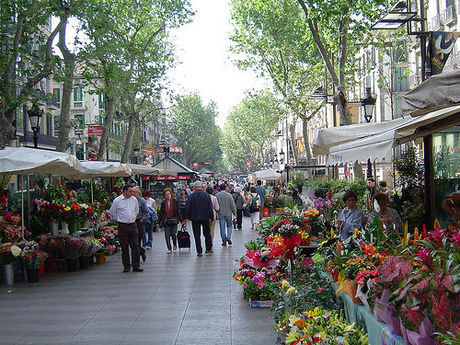La Rambla
La Rambla is the grand boulevard of Barcelona, with a length of 2 kilometres. La Rambla starts at the Placa de Catalunya and goes downhill to the puerta Barcelona. You can come to Barcelona for the 10th time in your life; La Rambla will never look the same. The boulevard changes its appearance with the years and seasons. La Rambla is always crowded with people. As the people change over the years, the Barcelona Boulevard changes as well.
La Rambla is a boulevard packed with living statues, mimes and people selling everything from lottery tickets to jewelry. Along the street you will find people of any age and social class, shoe shine boys, small stands selling flowers and vegetables, street theaters, big business galleries, cafeterias, terraces as well as some of the great theaters of the city.
La Rambla can be considered a series of shorter streets, each differently named, hence the plural form Las Ramblas. From the Plaça de Catalunya toward the harbour, the street is successively the Rambla de Canaletes, the Rambla dels Estudis, the Rambla de Sant Josep, the Rambla dels Caputxins, and the Rambla de Santa Monica. Construction of the Maremàgnum in the early 1990s resulted in a continuation of La Rambla on a wooden walkway into the harbor, the Rambla de Mar.
La Rambla can be crowded, especially during prime time tourist season. Most of the time, there are many more tourists than locals occupying the Rambla, which has changed the shopping selection, as well as the character of the street in general. Spanish poet Federico García Lorca once said that La Rambla was 'the only street in the world which I wish would never end'. The name rambla refers to an intermittent water flow in both Catalan and Spanish, and is derived from the Arabic 'ramla' which means 'sandy riverbed'. The name of the city of Ramla, now in Israel, shares the same origin.
More than just being a street, La Rambla preserves its original characteristics, containing history from different periods of time. Walking down la Rambla, you should visit the Mercat de la Boqueria . This is the most important and most visited market of Barcelona . The market has an incredible mix of colors, activity and great food. It is the best way to discover the Mediterranean cuisine; La boqueria Barcelona.
On Sundays, you may visit Pla Reial for an interesting market of coins and stamps. It is a beautiful square with palm trees, fountains and luxurious shops. Today, it is the heart of artists, a district with a truly charming ambience.
The next section of La Rambla boasts the Gran Teatre del Liceu, the famous 19th century opera house. Below the Pla Reial, La Rambla becomes a little shady, with steaming strip clubs and peep shows La Rambla ends at the lofty Monument a Colom (Monument to Columbus) and the harbor. Just west of the monument, on Avinguda de les Drassanes, stand the Reials Drassanes (Royal Shipyards), which house the Museu Marítim boasting boats, models, maps, paintings, ships' figureheads and 16th century galleys.
There is plenty of accommodation along the Ramblas in the form of hotels, hostels and apartments. Although the Ramblas offers you excellent access to the very heart of the city, it is worth remembering that if you choose accommodation on the Ramblas you must be prepared for noise. There is no getting away from this. Regardless of whether your hotel has double glazing or not, be prepared for some noise. There will even be street noise at night when the Ramblas can be busy until 3 a.m. or later. You can get there via direct flight to Barcelona or to Girona, Reus or Lleida – Alguaire.




